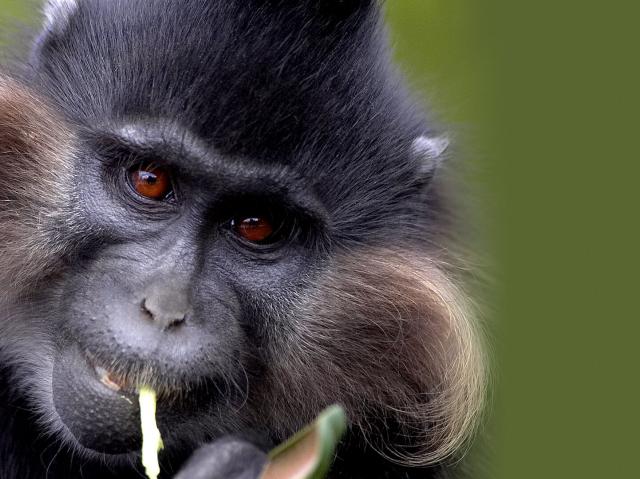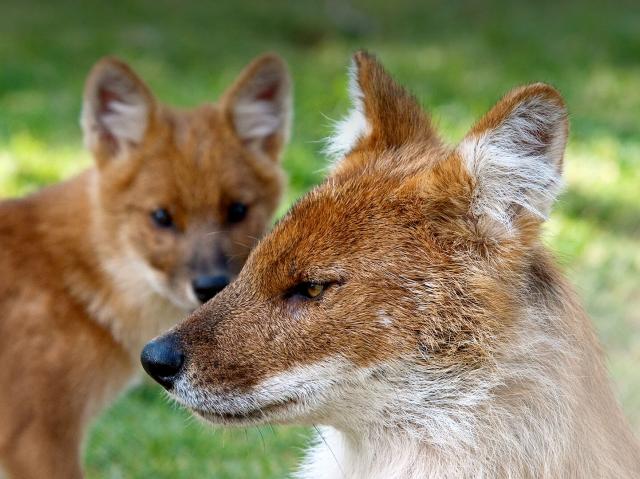
Wolf

- CLASS: Mammalia (Mammals)
- ORDER: Carnivora
- FAMILY: Canidae
- GENUS: Canis
- SPECIES: lupus, rufus, simensis

ABOUT
The misunderstood wolf: Most of us grew up hearing stories about the "big, bad wolf." But wolves are not really big or bad. They aren’t even harmful to humans! Wolves belong to the same family of animals, Canidae, as the dog you may have as a family pet. In some places they are considered a vulnerable or endangered species. There are many wolf organizations and government agencies working to both save wolves and educate people about them.
There are many stories of wolves being "wild dogs" that can be tamed. While wolves and dogs do share many biological traits, they are very different from each other. The dogs we have as pets have been bred to be gentle companion animals to humans. Wolves are still wild animals and should be treated as such. Sometimes wolves and dogs interbreed, and the pups are called wolf hybrids. However, these hybrids usually do not make good pets. There is another myth that some dog breeds, like the husky, are part wolf. But huskies are just another domestic dog breed, like a poodle or a golden retriever.
Wolves vary physically from one another. Desert dwellers like the Ethiopian wolf may weigh only 25 pounds (11 kilograms), but northern gray wolves like the tundra and Arctic wolf subspecies can reach 136 pounds (62 kilograms). Their coat color runs the full black-white color spectrum, with tan and reddish brown thrown in as well. There are two wolf species in North America, the gray and the red. Gray wolves are the most widespread, inhabiting parts of the U.S. but all of Canada as well as Europe and Asia and are split into several subspecies, including Arctic wolves and Australia’s dingoes, a subspecies that lives in just about any habitat there, from desert to rain forest. Ethiopian wolves are found only in the highlands of Ethiopia.
HABITAT AND DIET
Where are wolves found? Incredibly adaptable, wolves have inhabited, at one point, virtually all of North America, northern Europe, eastern Africa, and Asia. They tolerate a wide range of temperatures, from -70 to 120 degrees Fahrenheit (-50 to 48.8 degrees Celsius). All of their senses are keen, and they can run, climb, lope, and swim really well. Depending on their habitat and prey availability, wolf territories can range from 40 to 1,000 square miles (10,360 to 258,999 hectares). Wherever wolves live, it is usually away from human beings. Wolves tend to be cautious around people and avoid us if they can. Today, a large national park or wilderness area is where most wolves are found.
Wolves eat meat almost exclusively and feed on anything from mice to moose to musk oxen. In the wild, some observers have seen them eat small birds or mice, but they prefer larger prey such as goats, sheep, or deer. Wolves work as a team to attack herds of these large animals. They often go after the old, young, or sick, since they are easier to kill. Many times it is feast or famine for wolves. When they find food, they eat as much as they can, because they may go for many days before eating again.
Wolves can kill their prey effectively because they have incredibly strong jaws, which can bite through even the toughest of animal hides. They can break hard bones in just a few bites.
FAMILY LIFE
Wolves live in family groups called packs. A pack usually consists of an adult male and female and their pups. The average size of a pack is 8 or 9, but packs as large as 20 to 30 wolves have been found.
Wolf packs follow the cues of the head male and female, called the alphas. In any pack there is only one alpha male and female, and often these two have pups. The alphas are usually the ones with the strongest leadership skills and organize the pack to hunt as a group. Alpha pairs allow the pack to work as if with one mind. Clearly defined territorial boundaries reduce inter-pack fighting, and wolves constantly patrol and scent-mark their home turf. Howling also establishes territorial boundaries.
If you’ve watched domestic dogs play, you already know something about how wolves communicate. Within a wolf pack, communicating successfully with each other is key to every member’s survival and well-being. Like dogs, they may bare their teeth and growl as a sign of aggression or a threat to stay away, hold their tail high to signal heightened attention or anxiety of some kind, or lower their body and tail or even roll over onto their back as a sign of submission to another pack member. Ears flattened back against the face may indicate caution or anxiety of another sort.
Wolves, like many other animals, also communicate by scent marking: leaving their urine and feces on trees or rocks where other wolves will find it. There are many scientific studies going on to determine what these "messages" mean. Vocal communication includes a variety of whines, growls, barks, whimpers, squeaks, and howls.
One of the best-known ways wolves communicate is by howling, a soulful song that sounds both melodious and mournful, mysterious and sad. Yet contrary to those impressions, a wolf’s howl is a celebration: wolves love to make music! When a pack performs, one wolf begins, then after one or two howls, others join in. They warm up with a few long, low howls and work up to a series of shorter, higher howls in a chorus with others. A group howl may last more than a minute. It’s an excited and emotional ritual that is vital to maintaining pack unity and community spirit.
Wolves howl for many reasons, in solo or chorus. They howl upon waking up from a long sleep and to rally the pack prior to a hunt. The howl inspires enthusiasm, helps synchronize pack activities, and can be a song of the feast, announcing and defending a kill. Wolves also howl after intense play and social interactions or to communicate positions or keep in touch when separated. Howling creates an acoustic barrier to warn other wolves to stay away, outlining boundaries and signaling location, pack size, and strength.
Sometimes, wolves howl just for the fun of it! No two wolves hit the same note: they immediately change pitch until discord is reached to make the pack sound larger and more formidable.
Even though usually only the alpha male and female have pups, all of the wolf pack’s members take care of the youngsters. Pups are born in a den, which can be a depression in the ground or grass, a cave, burrow, hollow log, or fallen tree. Litter size can number from 1 to 11. The pups may be moved from one den to another as needed as they grow. They nurse for their first four weeks from their mother and one or more of the subordinate females in the pack.
All pack members assist with baby-sitting duties, too. Pups learn the complicated language of “wolf speak” that communicates through visual, tactile, and auditory ways at a very young age and are taught by all pack members. From 5 to 10 weeks of age, they add food regurgitated from other pack members to their diet. By 10 weeks old, the pups are ready for solid food and no longer depend on milk, but instead from food brought to them by the pack. At six months old, the youngsters join the adults in hunts, and by the time they are two years old, they are considered mature.
CONSERVATION
Wolf origins: About six million years ago, a small, foxlike North American carnivore was evolving into a large, 100-pound (45 kilograms) generalized predator that began living in packs. Gray wolves flourished to become the most widely dispersed land mammal on Earth, next to humans. Traveling across the Bering Strait, they fanned out into the Far East, Russia, and Europe, eventually crossing back into North America. Yet as human populations increased, wolves were seen as competitors for food and as a threat to human safety. This led to bounties that eliminated wolves from large areas and caused the steady decline of wolf populations.
Gray wolves: Gray wolves now occupy only a small percentage of their former range. Persecution continued in the U.S. until the 1970s, when only 500 to 1,000 wolves remained, gone from 95 percent of their historic range. In Canada, the wolf’s range was reduced by 15 percent, but in Mexico, it was totally depleted. Today, large wolf populations are restricted to the more remote and wild corners of the Earth, such as the Arctic.
In 1995, 14 gray wolf recruits from Canada were reintroduced to their home in our oldest national park, Yellowstone, after an absence of more than 60 years. By 2013, 95 wolves in 10 packs were counted, thriving there. The California Fish and Game Commission is reviewing a petition to list the gray wolf as an endangered species in the state.
Red wolves: The last natural population of red wolves in the wilderness lived in the coastal prairie marshes of Louisiana and Texas. Almost eradicated, red wolves were given a second chance by reintroduction efforts in eastern North Carolina’s wildlife refuges. Their current population is less than 150 individuals and dropping, as the wolves often breed with coyotes that recently moved into the area. Red wolves are also in several zoos as part of managed breeding programs in the U.S. and Canada, with the hope that one day there will be new safe areas to reintroduce the species.
Ethiopian wolves: Now considered endangered, Ethiopian wolves continue to lose their mountain habitat as the land is turned into farmland or pastures for grazing livestock or commercial sheep farms. Rabies and canine distemper have also reduced the wild populations, and many red wolves interbreed with domestic dogs. But there is hope! The species now has full official protection in Ethiopia, and those found killing a wolf will serve jail time of up to two years. A vaccination campaign for dogs living near wolf territory, sterilization of wolf hybrids, population surveys, and other steps are in place to help this canine predator.
By supporting San Diego Zoo Wildlife Alliance, you are our ally in saving and protecting wildlife worldwide.
Sounds
LIFE SPAN
13 to 15 years
YOUNG
Gestation: 9 weeks
Number of young at birth: 1 to 11
Weight at birth: 1 pound (.45 kilograms)
Age of maturity: 9 months
SIZE
Body Length: Largest - gray wolf, 2.8 to 4.3 feet (87 to 130 centimeters) long; Smallest - Ethiopian wolf, 2.7 to 3.3 feet (84 to 101 centimeters) long. Males are larger than females
Tail length: 11 to 20 inches (29 to 52 centimeters) long
Weight: Heaviest - gray wolf, up to 136 pounds (62 kilograms); Lightest - Ethiopian wolf, 25 to 42 pounds (11 to 19 kilograms)
FUN FACTS
Wolves can "wolf down" 20 pounds (9 kilograms) of food in one sitting.
When hunting, wolves can spring up to 38 miles per hour (61 kilometers per hour).
On the Arctic tundra, wolf howls can be heard up to 10 miles away.










